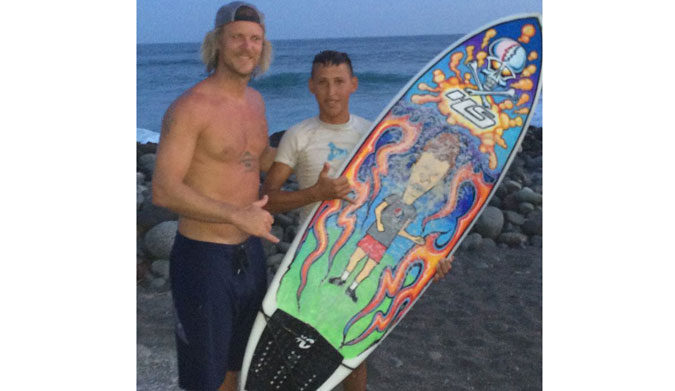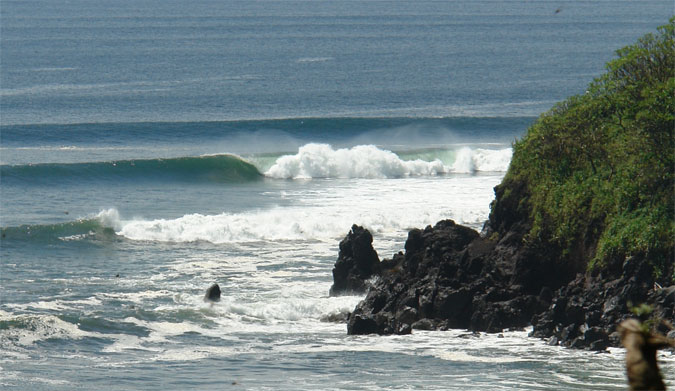George has a bone to pick with the U.S. State Department. A few days before my arrival, they released a new warning for U.S. citizens traveling to El Salvador. “It’s all bullshit,” said George, leaving little room for interpretation. In reality, the warning is written fairly evenly, discussing the statistics of crime in El Salvador and the typical instances in which it occurs. But there are more than enough phrases that stick out to prospective visitors: “Murder for hire,” “nine-year-old child,” and “U.S. citizens.”
I do, however, get a lot of semi-hostile looks in the Sonsonate strip mall, where I’ve gone to buy granola bars and fruit. But I’m a 6’3” blond gringo who speaks zero Spanish. I deserve the stink-eye.
George is an expat and the owner and proprietor of the Mizata Point Resort, a seven-room surf hotel located directly on one of El Salvador’s lesser-known right points. He has a vested interest in making American tourists realize that El Salvador is a safe destination. Since he found out I’m a writer, he’s been suggesting that I write an article centered around a gift: a surfboard given to a local kid, José, by another one of Mizata Point Resort’s guests.

José saved Butthead from the rocks when a fellow guest’s leash snapped. As a thank you, he received Butthead himself. Photo: Kim Stockton
“Surfing keeps the kids out of the gangs,” George explained. José had saved the board in question, a Hypto Krypto painted with Butthead’s sniveling corpus, from the rocks when a fellow guest’s leash snapped. It was an awesome move, but it was made more out of gratitude than charity. Besides, I don’t want to add another white savior narrative into the bullshit pot of feel-good-about-ourselves American travel writing. The story is this: El Salvador is awesome, José is awesome, and what José did—save a stranger’s board—is awesome. I went there to surf, so I’ll write about the waves I rode and the country where I rode them.
Mizata Point has two primary waves: a right point, which works best on low tides, and a rocky beach/reef setup called Tweeners, Boulders, or just The Beach. There’s an actual sand-bottom beach break, too, and a slab at its far end, but those are surfed far less often. The waves were there every day of my trip. Mizata is regularly two or three feet bigger than the more well-known spots in El Salvador. Neither wave is perfect. Tweeners has a short right and a playful, occasionally hollow left. The point is a very good wave with a steep drop, a fat middle section, and a racy, sometimes hollow inside section. According to a GPS surf watch, the longest rides there measured about 300 meters. However, they were usually closer to 200 meters.
I had the lineup to myself for the first hour of daylight basically every day. After that brief moment of solitude, the crowd would grow by between one and fifteen surfers, depending on how many vans showed up that day. As a general rule, the smaller the swell, the more crowded it got—Mizata always received more swell than the nearby breaks. My goal was to surf as much as I could and simply get better.
I surfed a lot, which is not to say I didn’t see what else El Salvador had to offer. The tourism industry is growing and the infrastructure is fairly solid. After surfing in the morning, I took a day to tour the country with Robert Broz Moran of Gringo Day Tours. He’s similarly incensed by the U.S. State Department’s travel warnings.
“99 percent of the U.S. citizens who get into trouble here are El Salvadorians who were born in the U.S. and came back to live here. They get involved in the gangs or their families do,” said Robert. Agreeing with Robert, George continued, “All of the violence here is gang-on-gang, gang-on-police, or police-on-gang violence. Tourists run no risk.”
But as we drive around El Salvador, there are signs that might hint otherwise. We eat at a restaurant guarded by a uniformed man toting a shotgun. Police with automatic rifles patrols the highway medians. At Punta Roca, our driver, a local surfer, insists he has to stay with his car.
But it’s the gangs that are the big black spot on the résumé of a country on the rise, according to Robert. “In education, infrastructure, agriculture, and industry, El Salvador is better than it was 16 years ago. And they’re really beginning to invest in tourism.”
On one of my last nights there, José and I have Tweeners all to ourselves—perfect chest-high peelers that seem to be almost automatic. José, a goofy-foot, is one of those wondergroms who catches ripples that turn into tubes. I still can’t speak his language, but I know how to tell him he just got a really good wave. And he’s kind enough to hoot through a few of my rail-digging, ass-dragging backhand turns. He’s constantly smiling, never aggressive, and always confident. He may or may not be riding his new Hypto Krypto. I didn’t check, but he’s ripping, either way.
José is growing up in a country dominated by gang culture. Surfing, however, is an unbelievably healthy activity that might provide some sort of alternative in José’s future. It’s awesome that José got a new board, but to try and paint the gift as charity doesn’t give José enough credit. For that matter, it doesn’t give El Salvador enough credit. Because it’s not pity that comes to mind when you drive along the cliff sides, checking headland pointbreak after headland pointbreak. It’s stoke. El Salvador is not a country in need of our help like some bullet-riddled charity case. It’s a country full of world-class waves and people who want to establish it as a world-class destination. Let’s start treating it that way.


